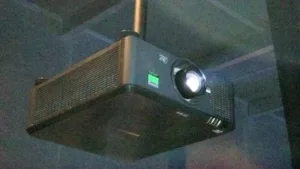The shift vs. native resolution debate got a little more intense at CEDIA with the debut of several prototype 4K projectors using the 4 million mirror TRP chip set from TI. This is a single DLP chip that uses an image shifting optic to create 8M pixels on the eye as seen by the eye. Digital Projection, Vivitek/Delta and Sim2 all showed prototype projectors based upon this chip.
The “shift” camp now has the above three as well as JVC and Epson, with the latter offering solutions using LCOS and Reflective LCD technology. The “native” camp is being championed by Sony, citing the better image quality of the native 4K approach at CEDIA. This camp also includes JVC who launched their own native 4K projector at CEDIA as well.
According to Digital Projection (DP) manager Michael Bridwell, PMA Research has now tried to add some clarity to this shift vs. native debate. They have now created three categories of 4K projectors, all of which can accept 1080p or 2160p source files. However, I have created four categories below based on the subpixels/mirrors used to create 4K images (comments welcome).
- 4K Supported: accepts 1080p or 2160p content and uses ~6M subpixels/mirrors to create the 4K-like full color image (JVC and Epson with 3-chip architectures)
- 4K UHD: accepts 1080p or 2160p content and uses ~4M subpixels/mirrors to create a 4K-like full color image (using TI TRP single-chip architecture – DP, Vivitek, Optoma, Sim2, etc.)
- 4K UHD Plus: accepts 1080p or 2160p content and uses ~12M subpixels/mirrors to create a 4K-like full color image (using TI TRP 3-chip architecture – DP, others?)
- 4K Native: accepts 1080p or 2160p content and uses ~24M subpixels/mirrors to create a true 4K full color image (Sony, Canon, JVC, NEC, Christie and Barco using 3-chip LCOS or DLP architectures)
The DP prototype was playing content in a darkened area and will be classified as 4K UHD by PMA Research. This E-Vision series projector fills a big hole in the market for DP allowing them to offer a 4K image with 8K lumens for an MSRP price point of around $20K. The image looked good, but black levels and colors need to be improved before shipping in April 2017.
A 3-chip version of this projector should be ready by January, but was not shown at CEDIA. This will be offered for around $45K MSRP and offer around 2000:1 native contrast. It will have about 12K lumens.
DP says both projectors will use a laser phosphor engine and they are working on the tone mapping for both these projectors now so they can offer an HDR-like image as well. However, with limited contrast and only global dimming, plus support for only the 709 color gamut, HDR images may not be as punchy as might be desired. – CC

